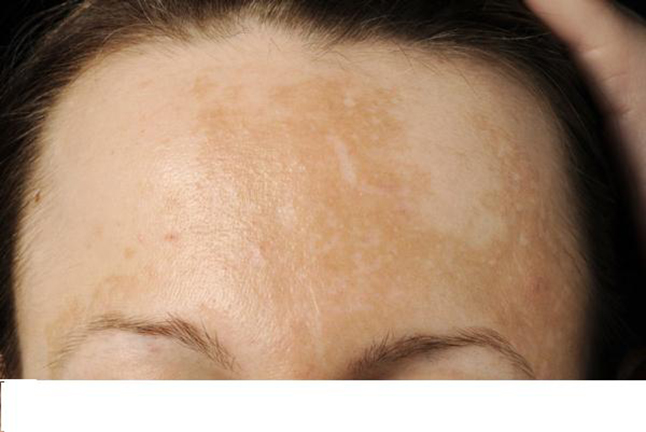-
(a) What is the most likely diagnosis?
Show Answer
The pigmentation is irregular and localised to the forehead. This is a typical appearance of melasma, also known as chloasma.
-
(b) How is this confirmed?
Show Answer
The diagnosis is made clinically. The pigmentation is caused by increased melanin in the epidermis and/or in the dermis; however, a biopsy is not usually helpful. Wood’s light (UVA) shows up the affected skin more obviously.
-
(c) What are the most likely causes?
Show Answer
The most common provoking factors are pregnancy and the oral contraceptive pill. If the patient is on the oral contraceptive pill, alternate contraception should be considered. The condition is usually seen in women, but about 10% of people affected are men. There is an association of melasma with thyroid abnormalities and so thyroid function tests should be checked.
-
(d) What are the most important aspects of managing this patient?
Show Answer
The pigmentation can cause considerable distress and so it is appropriate to have a two-pronged approach, providing practical immediate assistance while waiting for the inevitably slow improvement. Camouflage advice with cosmetics can be helpful if it is possible to refer the patient to a local camouflage service. As the pigmentation becomes more obvious when the patient becomes tanned after sun exposure, the patient should be advised to avoid direct sun exposure and to use sunscreens. Obvious precipitating factors, such as the oral contraceptive pill, should also be avoided.
-
(e) What specific topical therapy may be helpful?
Show Answer
The most effective topical therapy to reduce pigmentation is hydroquinone, and this may be given in combination with topical tretinoin and a topical corticosteroid such as fluocinolone. However, note that there are some risks of irregular depigmentation with this therapy, and topical tretinoin should not be used in pregnancy. Topical azaleic acid may also be helpful for melasma.
-
(f) What is the prognosis?
Show Answer
The condition usually gradually fades.


